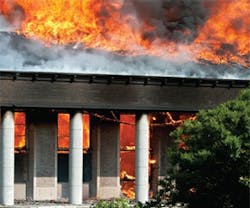A Guide to Automatic Sprinkler Systems
Building and fire codes often require installation of automatic sprinklers in a building based on certain factors, such as occupancy group, height, size of the building/fire area, and occupant load. If fire sprinklers aren’t explicitly mandated, the codes often make it highly advantageous to install them as an optional system by allowing for less expensive construction types (and thus less expensive building materials), larger floor area limitations, longer egress paths, and fewer requirements for fire-rated construction in structures protected by fire sprinklers, reducing the total building cost.
The design and installation criteria of a sprinkler system must follow national standards, such as the National Fire Protection Association’s (NFPA) Pamphlet 13. The building and fire codes require the installation of sprinklers, but the national standards themselves don’t require installation of sprinklers in buildings. Sprinklers may also be required by local ordinances or by insurance companies to reduce potential property losses or business interruption.
Here are the different types of automatic sprinkler systems and their uses.
Sprinkler System Types
Wet pipe systems. Wet pipe sprinkler systems are the most common type of fire sprinkler systems. They’re reliable because they are simple, composed of only automatic sprinklers and, usually, an automatic alarm check valve. An automatic water supply provides water under pressure to the system piping. All of the piping is filled with water. And, when the automatic sprinkler is exposed to sufficient heat, the heat-sensitive element (glass bulb or fusible link) releases, allowing water to flow from that sprinkler.
Dry pipe systems. Dry pipe systems should only be used in spaces in which the ambient temperature may be cold enough to freeze the water in a wet pipe system, rendering the system inoperable. In a dry pipe system, the piping is filled with maintenance air at a lower pressure than the water supply pressure, and a large valve clapper prevents the water pressure from forcing water into the piping. When one or more of the automatic sprinklers is exposed to sufficient heat, the valve opens, allowing the maintenance air to vent from that sprinkler. As the air pressure in the piping drops, water is allowed to enter the piping system. Water flow from sprinklers is delayed until the air is vented from the sprinklers. For this reason, dry pipe systems are usually not as effective in fire control during the initial stages of the fire.
Other sprinkler systems. Deluge, pre-action, foam-water, double-interlock, and water spray are some of the other, less-utilized sprinkler systems.
Final Thoughts
According to the NFPA, the average loss per fire in buildings with sprinklers was $2,300, compared to an average loss of $10,300 in unsprinklered buildings. The NFPA adds that there is no record of a fatality in a fully sprinklered building outside the point of fire origin; however, in a purely economic comparison, this is not a complete picture – the total costs of fitting and the costs arising from non-fire triggered release must be factored. Current statistics may be obtained from NFPA’s website.
Imad Naffa is the founder of Fresno, CA-based Naffa Intl., a multi-discipline consulting firm specializing in building code and engineering review services, along with online resources and tools related to the building codes.
